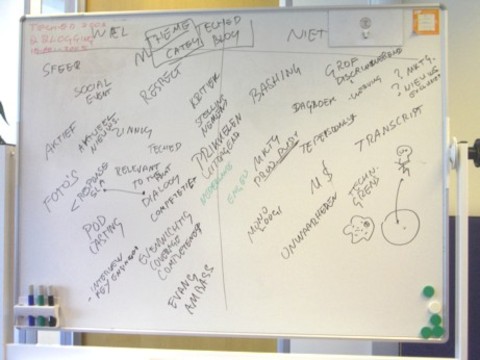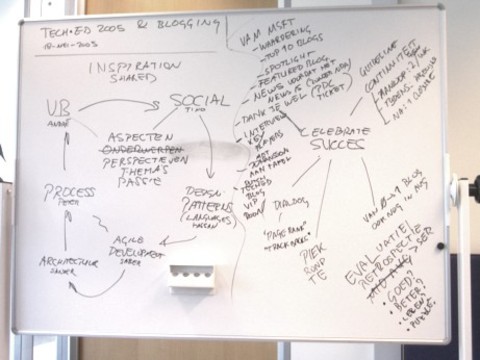The Virtual Community, Homesteading on the Electronic Frontier; Howard Rheingold (Author of Virtual Reality), Addison-Wesley Publishing Company.
ISBN 0-201-60870-7, $22.95
The Virtual Community by Howard Rheingold covers all aspects from a globally connected community. He starts at his participation in the WELL (Whole Earth ‘Lectronic Link), one of the first electronic virtual communities, and the social impact it had on his life and that of his family. Virtual communities can discuss very intimate topics, like leukemia for instance, that cause the whole virtual community to feel what’s going on at one of the member’s home. Even the virtual death of WELLite Blair Newman, removing–scribbling–every word he ever said, as well as Blair’s real death by suicide and its emotional consequences is discussed.
The complete history of the Net is discussed in length, from ARPANET to NREN, including the current explosion of the Internet. Bill Clinton and Al Gore play their roles too, of course. Media like Gopher and Usenet complete the picture, although WWW and Mosaic are not mentioned, probably because they emerged after this book got published. Not to be forgotten are the grassroot BBSs, small, cheap and simple virtual communities that are self-propagating and difficult to eradicate.
However, MUDs (Mutli User Dungeons)–imaginary worlds in computer databases where people make up their own world, rules and objects, yes, even magic–appear to be very addictive. One example mentions a addict “who managed to maintain a B average as an undergraduate, hold down a part-time job, and still find time to MUD for seventy hours a week or more.” In a more interesting variant of MUDs, MUSEs (Multi-User Simulation Environments), everyone is granted powers to shape the environment, not just wizards. MicroMUSE created Cyberion City, in which players build their own, complete environment by exploring and playing with it–here, playing is a powerful form of learning. “Dying” in a MUD–because you got shot by someone else, say–is experienced as a very emotional event, similar to the corresponding real life experience.
IRCs (Internet Relay Chat) are also MUD-like in the sense that they create a channel (i.e. “dungeon”) on which many people listen in and discuss and pose questions, “gesturing” and emoting by using the appropriate verbs. Here too, social behaviour plays a very important role
Then Rheingold discusses virtual communities and grassroots activities throughout Japan (COARA, TWICS), England (CIX) and France (Minitel, messageries rose), finding that at around the same time, various virtual communities emerged worldwide. And that these communities now tend to drift towards Internet and use it as the foundation for all communication.
In the section on Electronic Frontiers and Online Activists, Rheingold covers the history of Dave Hughes and his involvement in the Net. Then switches to the birth of the Electronic Frontier Foundation to fight hackers and intruders that endanger the life on the Net in various communities. This section mentions “Within days of the Pinedale meeting [where the EFF was founded], Steve Wozniak, cofounder of Apple
Computer, and John Gilmore, Unix telecommunications wizard and one of the first employees of the enourmously successful Sun Microsystems, offered to match Kapor’s [cofounder of Lotus] initial contributions.”
Also, application of new and emerging technologies, like high bandwidth networks, cause telecommunication companies, cable providers, entertainment companies, and computer companies to invest huge sums of money in developing and architecting the technology for video-on-demand applications. Joint ventures happen weekly, and even Apple and IBM joined forces and started Kaleida Labs. Everyone wants a slice of the pie, and Microsoft wants to put its own low-orbit sattelites into place.
Finally, Rheingold delves into “disinformacy” in which extreme evolutions of the Net into the future are discussed. One one side, the Net remains a free, democratic and organized chaos, but with some laws enforced to keep it habitable. On the other side, the Net turns into the ultimate prison (the Panopticon) in which “tyrants could use surveillance technologies to wield power.” Big Brother Extreme. The Net uses infromation about you to sell to others, maybe even blackmail you.
Rheingold ends with: “Armed with knowledge, guided by a clear, human-centered vision, governed by a commitment to civil discourse, we the citizens hold the lever at a pivotal time. What happens next is largely up to us.”
Personal notes
It seems to me that the building features of MUSEs can be very powerful, and very atractive to employ in a business environment. Combining this building feature of MUSEs with a visualization through realistic 3-D rendering by virtual reality can create the next computer revolution. It may well be one of the ways we can manage the huge amount information thrown at us every day of our life.
Powerful and affordable computer technology is becoming availabe to make these applications feasable to build and employ. That is, with the current processing power of a SPARCstation 20, combined with cheap SX/ZX-like (and beyond…) graphics power and ATM-like network bandwidth, highly visualized MUBEs (Multi-User Business Environments) come in reach.
Yet again, Sun is hardly mentioned in Rheingold’s book (only twice). In my perception however, Sun systems largely make up the worldwide backbone of the Internet (more than 80%?). Perhaps I’m wrong, or maybe I don’t read the right books. Also, the PC community (DOS, Windows and Macintosh) seems to take over the credits of the Internet explosion, not us.
Yet again, I think we must leverage (market) the fact that Sun’s products form the core of the Internet revolution! We fail to do so until now. This frustrates me.However, get this book (if you don’t have it already) and add it to your standard reading list
Regards,
Martien van Steenbergen.


